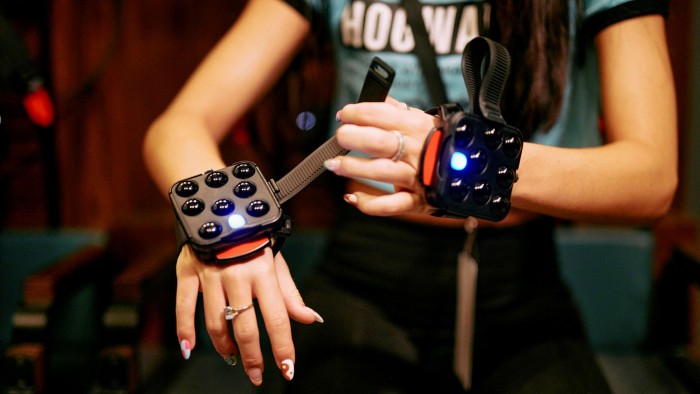The search for 5G’s ‘killer apps’

Roula Khalaf, Editor of the FT, selects her favourite stories in this weekly newsletter.
It has been three years since a Chinese surgeon performed liver surgery 30 miles from his animal patient, using a 5G telecoms network to control robotic arms.
At the time, the possibilities of 5G — the fifth-generation mobile network — may have seemed endless. But carriers now face an uphill battle to convince customers that it can offer something tangible and new to their lives.
Given the high capital expenditure on the rollout of 5G networks, and the full fibre optic infrastructure that underpins them, telecoms companies have been eager to find ways to monetise their creation.
Historically, though, it has taken time to identify the true value of each new generation of wireless networks.
Before 3G appeared, consumers were excited about the potential for superfast data speeds, but the reality at the start of the century fell short.
In 2009, when 4G arrived, those data speeds had already become a reality, and consumers began asking the same question: “what is the killer application of all of this?”
That year, Uber was launched and, over the next few years, video streaming became ubiquitous.
However, consumers around the world appear to be resuming a new cycle of deflated expectations.
This is in large part because it is becoming widely understood that 5G and the low latency (removal of delays) it offers will principally benefit businesses rather than consumers — at least for the time being.
“Things are about to change, but it’s difficult to postulate what those killer apps will be at this moment in time,” admits Santiago Tenorio, a network architect director who has worked at Vodafone for 27 years.
“2G, 3G and 4G were all about speed going up, whereas 5G is all about latency, for the very first time.”
According to a recent report by Ericsson, entitled “Five ways to a better 5G”, early adopters of the technology are pleased with the speeds but expect more innovation.
Seventy per cent say they are dissatisfied with the availability of innovative services and are waiting for new applications that will make use of 5G in cleverer and better ways.
The report found that consumers would be willing to pay 20 to 30 per cent more for mobile plans that bundled 5G with digital services, but that the majority of the use cases that had been touted — and were most appealing to consumers — had not yet materialised. They included 3D hologram calling, 5G in-car entertainment, and virtual reality shopping.
The business case
The advantages that 5G can bring businesses range from run-of-the-mill efficiencies to more glamorous cutting-edge applications.
Carriers have had to continually offer business customers more and more data without being able to sufficiently raise prices, but 5G now provides an economic way of carrying that extra data, according to Jeremy Thompson, executive vice-president of Huawei UK.
And, in addition to this financial advantage for carriers, there are a wide range of applications for corporate and business-to-business 5G customers. Ericsson has estimated that, if these B2B uses are fully realised, they could deliver an extra 35 per cent in revenue for service providers.
Applications include superfast private 5G networks within companies, which could replace WiFi, and let the network owner offer privileged access to those within an organisation.
This could be particularly advantageous in places where high-speed, high-capacity, low-latency connectivity is needed — such as factories and logistics companies. The technology is already allowing components and machines within factories to connect seamlessly, removing the need for cables.
Ericsson has built a fully functioning factory for 5G radios in Lewisville, Texas, that is operated by 200 5G robots, which the company says has increased efficiency and reduced costs.
Many also believe that 5G is on the cusp of enabling highly technical and complex activities to be performed from a distance.
Jan Soderstrom, head of Ericsson’s technology office in Silicon Valley, describes a logistics project at an Italian port, where technicians can simulate where to move shipping containers using a so-called ‘digital twin’ environment.
Similarly, Huawei has described how low-latency 5G robots were deployed at a nuclear facility to clean up waste, using real-time video to stream their activities.
What does 5G offer consumers?
The one clear application that 5G is poised to augment is gaming. Soderstrom argues that for virtual and augmented reality, “5G is the secret sauce.” For example, at a 5G lab, Ericsson has worked with a host of partners to create a proof-of-concept immersive Harry Potter VR experience, called Chaos at Hogwarts.
The idea is that the 5G network allows gamers to fully immerse themselves in the virtual world without any lag, and without heavy battery backpacks that last about 20 minutes. The processing instead takes place at the edge of the 5G network so that, as soon as a player moves their head, the image changes imperceptibly.
Tenorio from Vodafone agrees that the real consumer 5G evolution will come through these virtual and immersive world developments — most commonly, for the time being, in gaming.
“Latency is what matters when you’re trying to overlay a virtual world on to the natural world,” he says. “If it’s slower than 20 milliseconds, your brain tells you something’s wrong.”

The Ericsson report found that 5G customers spend two hours more per week on cloud gaming, compared with 4G users. and one hour more per week on augmented reality (AR) apps.
What’s more, 20 per cent of 5G customers said they had decreased their use of WiFi after upgrading.
But many of these use cases are still in nascent stages. They make little difference to most people contemplating whether to upgrade to a 5G handset. To this customer segment, therefore, 5G — until proven otherwise — may appear to have been a damp squib.
Optimists, however, insist that the greatest innovations are yet to come. Build, they say, and the applications will follow. “5G is coming,” Tenorio declares, “and the 5G we have today is not the one we’ll have in the field five years from now.”

Comments